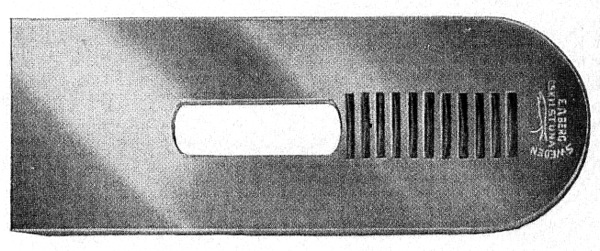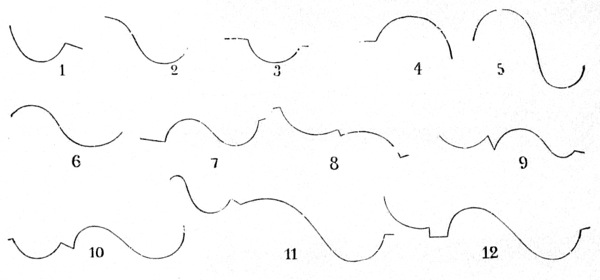Berg Plane Blades
1. Scrub Plane Iron – No Berg number, single and double
 Comments: This plane blade is mentioned in the 1896 Berg catalog price list as single blade. It also appears in the 1899 Berg catalog with a single and double blade option. It is absent from the 1936 Berg catalog and it seems to have been replaced by Berg’s Round Nose Plane Irons 902, 902-1/2 and 903.
Comments: This plane blade is mentioned in the 1896 Berg catalog price list as single blade. It also appears in the 1899 Berg catalog with a single and double blade option. It is absent from the 1936 Berg catalog and it seems to have been replaced by Berg’s Round Nose Plane Irons 902, 902-1/2 and 903.
Reference: 1896 (price list), 01-05-1899
~~~~~~~~~~~~~~~~~~~~~~~~~~~~~
1a. Block Plane Iron – 25
Comments: None
Reference: 01-08-1936
~~~~~~~~~~~~~~~~~~~~~~~~~~~~~
2a. Plane Iron – 878 single, 879 double, 880 single, 881 double
Comments: Opening in chip breaker, but no slot for Stanley Bailey type lateral adjustment lever.
Reference: 01-05-1936
~~~~~~~~~~~~~~~~~~~~~~~~~~~~~
3a. Plane Iron – 882 single, 883 double
Comments: Opening in chip breaker and slot for Stanley Bailey type lateral adjustment lever.
Reference: 02-05-1936
~~~~~~~~~~~~~~~~~~~~~~~~~~~~~
4a. Plane Iron – 890 single, 891 double
Comments: None
Reference: 03-05-1936
~~~~~~~~~~~~~~~~~~~~~~~~~~~~~
5a. Plane Iron – 894 single, 895 double
Comments: None
Reference: 04-05-1936
~~~~~~~~~~~~~~~~~~~~~~~~~~~~~
6a. Plane Iron – 896 single, 897 double
Comments: None
Reference: 05-05-1936
~~~~~~~~~~~~~~~~~~~~~~~~~~~~~
7a. Common Plane Iron – 900 single with slot, 900-1/2 single without slot, 901 double
Comments: None
Reference: 01-06-1936
~~~~~~~~~~~~~~~~~~~~~~~~~~~~~
8a. Round Nose Plane Iron – 902 single with slot, 902-1/2 single without slot, 903 double
Comments: None
Reference: 02-06-1936
~~~~~~~~~~~~~~~~~~~~~~~~~~~~~
9a. Plane Iron (American Model) – 904 single, 905 double
Comments: None
Reference: 03-06-1936
~~~~~~~~~~~~~~~~~~~~~~~~~~~~~
10a. Hollow Nose Plane Iron – 907 double
Comments: None
Reference: 04-06-1936
~~~~~~~~~~~~~~~~~~~~~~~~~~~~~
11a. Skew Plane Iron – 908 single, 909 double
Comments: None
Reference: 05-06-1936
~~~~~~~~~~~~~~~~~~~~~~~~~~~~~
12a. Toothed Plane Iron – 910 (large, medium, and fine toothed)
Comments: None
Reference: 01-07-1936
~~~~~~~~~~~~~~~~~~~~~~~~~~~~~
13a. Square Rabbet Plane Iron – 911 single without slot
Comments: None
Reference: 02-07-1936
~~~~~~~~~~~~~~~~~~~~~~~~~~~~~
14a. Square Rabbet Plane Iron – 912 double
Comments: None
Reference: 03-07-1936
~~~~~~~~~~~~~~~~~~~~~~~~~~~~~
15a. Grooving Iron – 913
Comments: None
Reference: 04-07-1936
~~~~~~~~~~~~~~~~~~~~~~~~~~~~~
16a. Plough-bit – 914
Comments: None
Reference: 05-07-1936
~~~~~~~~~~~~~~~~~~~~~~~~~~~~~
17a. Sash Frame Plane Iron – 915
Comments: None
Reference: 06-07-1936
~~~~~~~~~~~~~~~~~~~~~~~~~~~~~
18a. Moulding Plane Iron – 916
Comments: None
Reference: 07-07-1936
~~~~~~~~~~~~~~~~~~~~~~~~~~~~~
19a. Fillet – 917
Comments: None
Reference: 01-08-1936
~~~~~~~~~~~~~~~~~~~~~~~~~~~~~
Comments: These are the various Berg 917 fillet blade shapes.
Reference: 02-08-1936
~~~~~~~~~~~~~~~~~~~~~~~~~~~~~




















The no 895 double iron is very interesting in that the chip breaker (at leads in the illustration) is marked in a way I have never seen. If that stamp really made it into production, it must be a rare one.
I have never seen that marking either, except as an illustration in the 1936 Berg Catalog.
The Berg 895 double plane iron looks odd, as do 891 and 897. I have never seen real examples of any of them. I’m also a bit mystified about their design, intended use, and even how the cap iron (chipbreaker) is attached to the blade.
The 895 is certainly odd. I have a single iron which could be a straight edged no 895 ground skew, or could be a original skew cutter no 908.
https://www.flickr.com/photos/finnberg68/sets/72157647791919539/
Oh, and to answer the question about how the chip breaker was attached, I don’t think they used any other method than the usual one, even though the chip breaker isn’t pictured with a screw hole.
I wonder what purpose, if any, that little tab at the top of the slot hole on the 894 and 895 serves?
Maybe the tab at the top of the slot hole prevents the screw from being tightened too much. I have a double plane blade (not a Berg, but an old English one) with no chipbreaker hole. The female part is actually raised slightly, like a cone, providing sufficient depth to tighten.
Without the tab and in a hurry, one might tighten quickly and punch a hole throrugh the chip breaker.
Why this would be bad I have no clue.